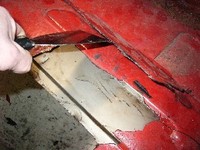
One of the ugliest jobs I've done while stripping down an old 240Z has been removing the tar-like insulation that covers much of the interior floorboards and transmission tunnel. I have done it by using aircraft paint stripper, but this was a big mess. It softened up the tar, but made it flow into low spots. Once I had most of it removed with a paint scraper, I had to use a wire wheel and more paint stripper to get the last of it off. Some have suggested using heat, but I'd think this would also be a mess. There must be a better way.
Actually, I found that with no chemicals at all, some of the insulation will come off quite easily. Just get the corner of a paint scraper under it and it flakes right up and breaks off. That's the good news. The bad news is that, unfortunately, these pieces come off easily because of what's underneath--rust! The insulation that covers clean metal doesn't want to budge.


A few years ago, a fellow racer had said that dry ice was the best way to clean off this insulation. I saw it mentioned a couple of other places on the internet, but I couldn't find any articles about it. Armed with just a few instructions of how to do it, I decided to give it a try. I would try to use dry ice to remove the insulation tar in the rear hatch/ trunk area of the old 240Z.
Getting the dry ice was easier than I thought. My local Kroger stocks it for 99-cents a pound. They broke open a ten pound bag to sell me 5 pounds. I brought it home and tried to break it up into as small chunks as I could. Then I simply spread it on top of the insulation tar. All the areas I treated were level. I don't know what is the best way to apply the dry ice to vertical areas like a transmission tunnel.


I got a really good feeling about this process when, before I was finished spreading the dry ice, I could hear cracking sounds where the dry ice had been sitting for a few minutes. Due to the cold, the tar must have been shrinking faster than the metal and finally becoming separated from it! Once I had spread out the dry ice as best I could and broken it into as small chunks as seemed reasonable, I went inside to watch the finish of the Daytona 500 and to eat supper.
I came out about two hours later. All the dry ice had melted (had become CO2 gas and sunk invisibly to the floor and out of the garage). I started attacking with my paint scraper.



Now, with minimal effort, chucks of the insulation as big as 3-by-9-inchs broke right off. In just a couple of minutes I had removed almost all of the insulation tar.


The bad news is that I found some really nasty rusty areas that I wasn't aware of. But they will be fairly easily repaired. I'm glad I know about them.
I did not try one technique that I had read about elsewhere--to use a hammer to strike the insulation. It is supposed to just shatter like glass. I was afraid this would leave dents in the underlying metal. And, if I remember it correctly, you're supposed to strike it when it's still cold (and mine wasn't really dry-ice-cold when I tried to remove it).
I didn't get every bit of the insulation. I think there were some spots where I didn't spread the dry ice thoroughly enough, so I guess the insulation didn't get cold enough. So it looks like I'll go back in a few days and repeat the process on those spots.
This was an incredibly effective and simple process and I will highly recommend it to anyone who wants to remove this material from any type of vehicle. It didn't involve any nasty chemicals, and didn't leave anything to clean up. Obviously there are precautions to take--I used leather gloves to handle the ice. It gives off CO2 gas, so make sure you have some fresh air to breathe. Other precautions will usually be listed on the package of your dry ice.




Recommended Comments
There are no comments to display.
Create an account or sign in to comment
You need to be a member in order to leave a comment
Create an account
Sign up for a new account in our community. It's easy!
Register a new accountSign in
Already have an account? Sign in here.
Sign In Now